Class 10 Exam > Class 10 Notes > Science Class 10 > Overview: Our Environment
Overview: Our Environment | Science Class 10 PDF Download
| Table of contents |

|
| Ecosystem - What are its Components? |

|
| Food Chains and Webs |

|
| How do our Activities affect the Environment? |

|
| Ozone Layer and How it is getting Depleted |

|
We often hear the term 'environment' on television, in newspapers, and from people around us. Our elders tell us that the 'environment' is not what it used to be; others suggest that we should work in a healthy ‘environment’. Global summits involving both developed and developing countries are frequently held to discuss ‘environmental' issues. In this section, we will explore how different parts of the environment interact and how we affect it.
Ecosystem - What are its Components?
- Environment is comprised of living (biotic) as well as non-living (abiotic) components. Our environment has undergone a great change since olden times.
- Specific enzymes are needed to break down a particular substance. Human-made materials like plastics are not broken down by the action of bacteria or other saprophytes.
- Substances that are broken down by biological processes are called biodegradable. Substances that are not broken down by biological processes are called non-biodegradable. Such substances may be inert and simply persist in the environment for a long time or may harm the various members of the ecosystem.
- All organisms such as plants, animals, microorganisms and human beings as well as the physical surroundings interact with each other and maintain a balance in nature.
- All the interacting organisms in an area together with the non-living constituents of the environment form an ecosystem.
- Biotic components comprise of living organisms like plants, animals and microorganisms and abiotic components comprise physical factors like temperature, rainfall, wind, soil and minerals.
- A garden is an ecosystem. There are different plants such as grasses, trees, flower-bearing plants, and animals like frogs, insects and birds. All these living organisms interact with each other and their growth, reproduction and other activities are affected by abiotic components of the ecosystem.
- Different kinds of ecosystems are forests, ponds, lakes, deserts etc. These are all natural ecosystems. Gardens and crop fields are examples of human-made (artificial) ecosystems.
Food Chains and Webs
ActivitySet up a human-made ecosystem.
An aquarium is a human-made ecosystem. It can be set-up as follows :
Requirements: A large jar, water, oxygen pump, fish food.
Procedure:
- Take a cubical glass vessel or a large jar.
- Fit an oxygen pump (aerator) to supply oxygen to the system.
- Fill the vessel or jar with water upto 90%.
- Add a few aquatic plants and fish into the vessel.
- The aquarium is ready. It is an example of a human-made ecosystem.
Clean the aquarium once in a week to keep it running.
- Organisms can be grouped as producers, consumers and decomposers according to the manner they obtain their sustenance from the environment. Hence, the energy available at each trophic level gets progressively due to loss of energy at each level.
- All green plants and certain blue-green algae which can produce food by photosynthesis are called producers.
- Organisms which consume the food produced, either directly from producers or indirectly by feeding on other consumers are the consumers.
- Consumers that feed on plants are called herbivores. For example, rabbit, horse, etc.
- Consumers that feed on small animals are called carnivores. For example, lion, tiger, wolf, etc.
- Consumers that feed on plants and animals both are called omnivores. For example, cat, dog, etc.
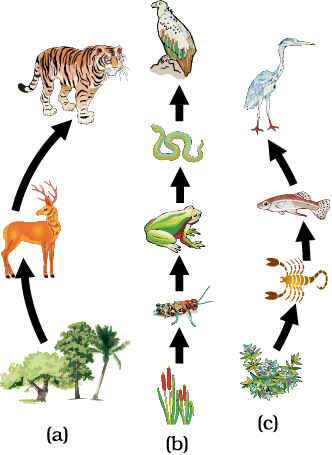 Food Chain in Nature(a) in forest, (b) in grassland and (c) in a pond
Food Chain in Nature(a) in forest, (b) in grassland and (c) in a pond - Parasite is another class of consumers. These are the organisms that live on or in the body of another organism from which they obtain their food. For example, parasites of man include fleas and lice, various protozoans and tapeworms.
- Microorganisms comprising bacteria and fungi, break down the dead remains and waste products of organisms. These microorganisms are called decomposers.
- Natural replenishment of soil will not take place in the absence of decomposers. Decomposers break down the complex organic substances into simple inorganic substances that go into the soil and are used again by the plants.
- Series of organisms feeding on one another at various levels form a food chain.
- Each step of level of the food chain forms a trophic level. Organisms at the first trophic level are called autotrophs. In fact, these are the producers. They fix up solar energy and make it available for consumers.
- Heterotrophs are the consumers.
- Various trophic levels are indicated in the figure below. The producers occupy the first level as shown in the figure.
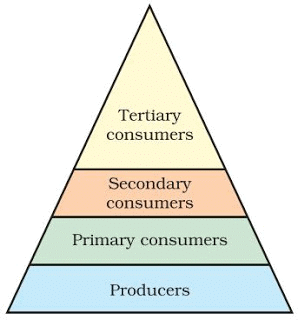
- The herbivores or primary consumers are at the second level. Small carnivores or secondary consumers are at the third level while larger carnivores or tertiary consumers form the fourth trophic level.
- The interactions among various components of the environment involve flow of energy from one component to the other. When one form of energy is changed to the other, some energy is lost to the environment which cannot be used again.
- Green plants capture about 1% of the energy of sunlight that falls on their leaves and converts it into food energy.
- An average of 10% of the food eaten is turned into its own body and is made available to the next level of consumers. Thus, 10% can be taken as average value for the amount of organic matter that reaches the next level of consumers.
- The loss of energy at each step is so great that very little usable energy is left after four trophic levels.
- There are a greater number of individuals at a lower trophic level, the maximum is that of the producers.
- Each organism is generally eaten by two or more other kinds of organisms which, in turn, are eaten by several other organisms. The different food chains starting from the same producers are called a food web.
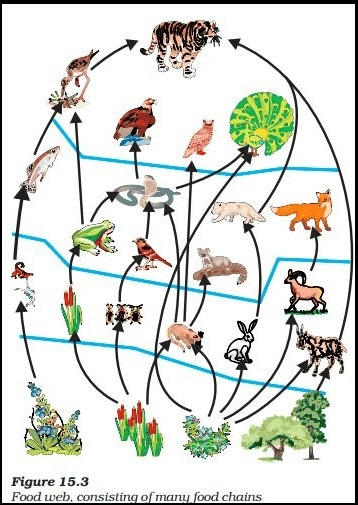
- The flow of energy is unidirectional. The energy captured by the autotrophs from the sun does not revert to the Sun and the energy which passes to herbivores does not revert back to autotrophs. Thus, energy is never available to the previous level.
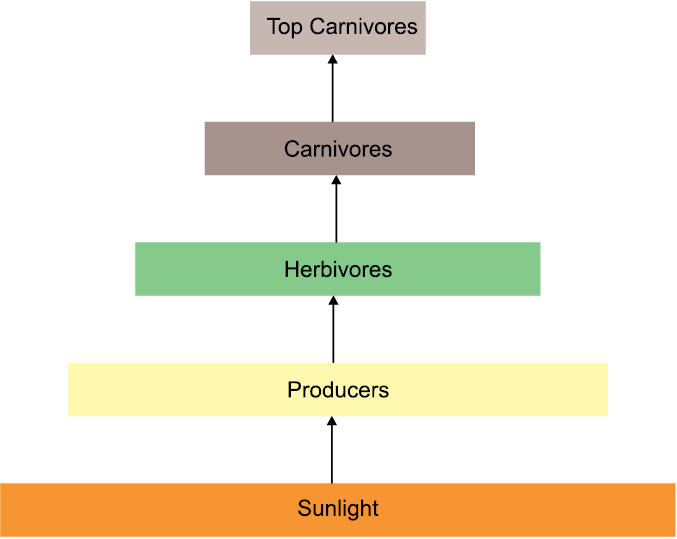
- Some harmful chemicals enter our body through the food chain. Several pesticides used to protect our crops from diseases and pests are washed down into the soil or into water bodies.
From the soil, these are absorbed by the plants and from the water bodies, these are taken up by aquatic plants and animals. - Human beings occupy the top level in any food chain.
Therefore, maximum concentration of the harmful chemicals get accumulated in our bodies. This phenomenon is called biological magnification. - Foodgrains like wheat and rice, vegetable and fruits and even meat contain varying amounts of pesticide residues through the food chain.
How do our Activities affect the Environment?
Ozone Layer and How it is getting Depleted
- Ozone (O3) is made up of three oxygen atoms. While O2, the oxygen we breathe, is vital for life, ozone can be harmful. However, in the upper atmosphere, ozone plays a crucial role by protecting the Earth from harmful ultraviolet (UV) rays from the Sun, which can cause skin cancer in humans.
- Ozone is formed at higher level of atmosphere by the action of UV rays on oxygen as shown below:
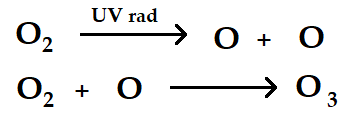
- The amount of ozone in the atmosphere has dropped significantly since 1980, due to use of synthetic chemicals like chlorofluorocarbons (CFCs) which are used as refrigerants and in fire extinguishers.
- In 1987, the United Nations Environment Programme (UNEP) succeeded in bringing about an agreement to freeze CFC production at 1986 levels.
Managing the Garbage we Produce
- Specific enzymes are needed for breakdown of specific substances. Hence, one enzyme will not work for all substances. Also, not all substances can be broken down by enzymes. Such substances are called non-biodegradable. They may persist in the environment.
- We find lots of garbage around us in the towns and cities. Improvement in our lifestyle has resulted in greater amounts of waste material generation. Changes in packaging have resulted in much of our waste becoming non-biodegradable. These factors have an adverse impact on our environment.
The document Overview: Our Environment | Science Class 10 is a part of the Class 10 Course Science Class 10.
All you need of Class 10 at this link: Class 10
|
80 videos|661 docs|80 tests
|
FAQs on Overview: Our Environment - Science Class 10
| 1. What are the main components of an ecosystem? |  |
Ans.An ecosystem consists of biotic components (living organisms like plants, animals, and microorganisms) and abiotic components (non-living elements such as air, water, soil, and climate). These components interact with each other, forming a complex web of relationships that sustain life.
| 2. How do food chains and food webs differ? |  |
Ans.Food chains represent a linear sequence of organisms through which energy and nutrients flow, starting from producers to various levels of consumers. In contrast, food webs illustrate a more complex network of interconnected food chains, showing how different species are interrelated and how energy moves through an ecosystem.
| 3. What activities contribute to environmental degradation? |  |
Ans.Human activities such as deforestation, pollution, industrialization, overfishing, and urbanization significantly impact the environment. These actions can lead to habitat destruction, loss of biodiversity, and climate change, ultimately affecting the health of ecosystems.
| 4. What is the ozone layer and why is it important? |  |
Ans.The ozone layer is a region of the Earth's stratosphere that contains a high concentration of ozone (O3) molecules. It is crucial for life on Earth as it absorbs the majority of the Sun's harmful ultraviolet (UV) radiation, protecting living organisms from its damaging effects.
| 5. How is the ozone layer getting depleted? |  |
Ans.The depletion of the ozone layer is primarily caused by human-made chemicals called chlorofluorocarbons (CFCs) and halons. When these substances are released into the atmosphere, they break down ozone molecules, leading to thinning of the ozone layer, particularly over polar regions.
Related Searches
















